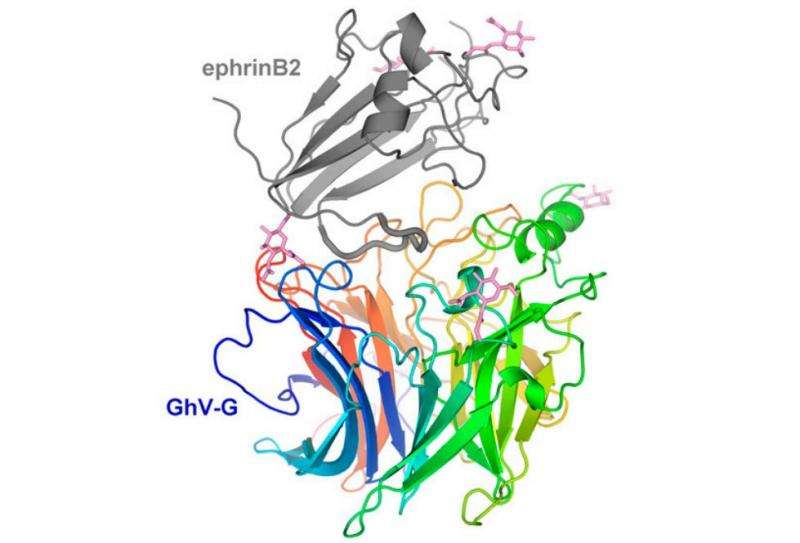April 14, 2015 report
Host cell-entry mode of African henipavirus could be its Achilles heel

(Phys.org)—The recognition of a suite of African henipaviruses (HNVs), which are related to pathogenic Hendra and Nipah viruses, is a wake-up call to medical organizations worldwide. The initial symptoms of henipavirus infection—fever and headache followed by rapid-onset encephalitis—have likely resulted in misdiagnosis by medical workers as malaria-associated encephalitis, and fatalities from infection approach 90 percent. As a result of the symptomatic commonalities between henipaviruses and other paramyxoviruses, researchers are now reassessing the spread of HNVs.
Since the 1990s, more than 20 henipaviruses have been detected throughout Africa, Asia, Australia and Central America. The virus resides in populations of Old World fruit bats and its introduction to humans is believed to be through animal intermediaries such as pigs, or through the slaughter of the bats themselves for meat. HNVs are extremely pathogenic, and have been designated as high-priority agents that require handling under stringent biosafety conditions.
Due to the potential for spillover from animal to human populations, researchers are focusing on the molecular-level structure of the viruses in order to determine their host-cell entry activities. A group of U.S.- and U.K.-based researchers have recently published a paper in the Proceedings of the National Academy of Sciences that studies a human cell surface receptor recognized by an emergent African hepinavirus strain called GhV, derived from a Ghanian fruit bat. They found that despite targeting a particular binding scaffold that exists across a range of HNVs, the molecular differences between these viruses prevented cross-reaction of antibodies, inhibiting development of a vaccination strategy.
Currently the only African HNV for which envelope sequence information is available, GhV is related to other highly contagious HNVs, and the researchers find that it displays an HNV-G β-propeller binding scaffold similar to that in Asiatic HNVs. Despite structural differences, these structures are capable of of accommodating nearly identical primary ephrinB2-binding modes at the surfaces of host cells. The researchers note that bat and human cell-surface ephrinB2 sites are quite similar and likely maintain similar modes of binding, and that cross-infections are therefore likely.
They write, "… the apparent structural plasticity and low level of sequence conservation on the HNV-G receptor-binding β-propeller scaffold are likely to prove an obstacle in the rational design of vaccines that produce broadly neutralizing antibodies to the ever-expanding spectrum of HNVs and HNLVs."
The virus-receptor interaction was confirmed via crystallography, and the researchers noted significant structural differences with previously documented HNV-G-ephrinB2 structures, but not in the key fold of the bound ephrinB2. They conclude that this conserved mode of ephrinB2 interaction represents an evolutionary constraint across divergent HNVs.
Through structure-based phylogenic analysis, the researchers found that GhV-G and its cognate in Asiatic NiV likely evolved separately, after the viruses bifurcated from a common ephrin-binding HNV ancestor. They speculate that the ephrin-2 binding site represents a constraint of evolution that has conserved ephrinB2 binding by HNVs, a potential Achilles heel that could be exploited in vaccine research.
The researchers introduced GhV to antibodies against NiV, finding that they did not cross-react with the GhV-G binding scaffold. Those antibodies also failed to neutralize CedV, a distantly related HNV. Despite a failure to find these cross-reactions, the researchers note that all of the studied HNVs mediate ephrinB2-dependent host-cell entry, and suggest that prime-boost vaccination is a possible strategy for eliciting broadly neutralizing antibodies that can target the ephrinB2-binding sites across a diverse HNVs.
More information: "Molecular recognition of human ephrinB2 cell surface receptor by an emergent African henipavirus." PNAS 2015 ; published ahead of print March 30, 2015, DOI: 10.1073/pnas.1501690112
Abstract
The discovery of African henipaviruses (HNVs) related to pathogenic Hendra virus (HeV) and Nipah virus (NiV) from Southeast Asia and Australia presents an open-ended health risk. Cell receptor use by emerging African HNVs at the stage of host-cell entry is a key parameter when considering the potential for spillover and infection of human populations. The attachment glycoprotein from a Ghanaian bat isolate (GhV-G) exhibits <30% sequence identity with Asiatic NiV-G/HeV-G. Here, through functional and structural analysis of GhV-G, we show how this African HNV targets the same human cell-surface receptor (ephrinB2) as the Asiatic HNVs. We first characterized this virus−receptor interaction crystallographically. Compared with extant HNV-G–ephrinB2 structures, there was significant structural variation in the six-bladed β-propeller scaffold of the GhV-G receptor-binding domain, but not the Greek key fold of the bound ephrinB2. Analysis revealed a surprisingly conserved mode of ephrinB2 interaction that reflects an ongoing evolutionary constraint among geographically distal and phylogenetically divergent HNVs to maintain the functionality of ephrinB2 recognition during virus–host entry. Interestingly, unlike NiV-G/HeV-G, we could not detect binding of GhV-G to ephrinB3. Comparative structure–function analysis further revealed several distinguishing features of HNV-G function: a secondary ephrinB2 interaction site that contributes to more efficient ephrinB2-mediated entry in NiV-G relative to GhV-G and cognate residues at the very C terminus of GhV-G (absent in Asiatic HNV-Gs) that are vital for efficient receptor-induced fusion, but not receptor binding per se. These data provide molecular-level details for evaluating the likelihood of African HNVs to spill over into human populations.
Journal information: Proceedings of the National Academy of Sciences
© 2015 Phys.org



















